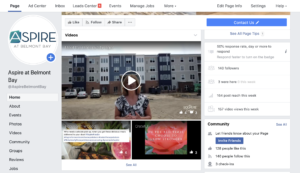
Our SAG Creator Series brings you tips, how-to’s, and general information from our team of creative experts on everything from innovative website and social media content to effective email campaigns to eye-catching printed mailers.
If your community has a Facebook page, you’ve likely seen big increases in traffic and interactions during COVID-19 lockdowns. Our communities have seen traffic numbers increase anywhere from 75 percent to 400 percent, depending on how their page is being used and how often content is shared. And for those communities that have put the right practices in place, that boost in traffic and engagement is helping to build a strong new resource for leads, while better telling the story of those communities and the people who live and work in them.
Here is a starter guide to improve your Facebook presence and engage your online community, giving you another way to share your message and build a strong lead generation engine.
Step 1: Know What You Want Out Of Facebook
Watching your Facebook followers increase is exciting, and seeing them react positively to your posts can give you an ego bump, but that’s not likely going to help build awareness or lead to people moving in without a plan in place. Think about your ultimate goals: Do you want a larger share of voice in your market? Are you looking for more leads? Are you trying to build stronger relationships with existing residents? Keep the end goal in mind and use Facebook to entice people to get to that destination.
Step 2: Be Authentic When Telling Your Story
Whether it’s the story of your community, the residents that call it home, or the team members and staff that help it all work, an honest story is one that will be the most successful. This has been especially important during COVID-19, as we all search for ways to help people learn about our communities without actually stepping foot inside. Sometimes the smallest things are the most engaging. Unique details will give potential residents and caregivers a better understanding of your community and what makes you different, and that goes a long way to helping separate you from your competition.
Step 3: Think About Your Audience
Knowing who you’re talking to (and why) will help you figure out what to say and how to say it. And while staying true to your community and your story is important, you need to know how to connect with the people you want to reach. This can be as simple as the language you use or as complicated as how you structure an advertising campaign. A good place to start is to consider how the things you are sharing will benefit the residents, their family or care providers, or potential employees. Then put context around the stories you are sharing to help those audiences see the benefits.
Step 4: Don’t Stop At Facebook
Facebook is a great place to make introductions and touch base with people you know, but you want the conversations to happen on your website. It’s rare for people to visit your Facebook page – it’s more likely they’ll see (and hopefully “Like”) individual posts in their newsfeeds, which are filled with other posts to grab their attention. Include links to your website in your posts to give people the option to learn more about the stories or news you share. This also puts them in an environment where they can explore more about your community, and more importantly, share their information to become a new lead.
Step 5: Invest In Ads To See The Best Results
The days of Facebook being a free way to advertise and promote your community are long gone. Less than 1% of your actual followers are likely to see your Facebook posts. That doesn’t mean organic, free Facebook posts aren’t important, but if you want this to be a lead generation channel, you’ll need to invest in Facebook Ads. A small budget can go a long way with the right combination of messaging and targeting, especially when paired with the right experiences and conversion environments on your website.
Step 6: Track Your Success To Repeat Victories
Facebook offers plenty of information on what’s working and what’s not working in Business Manager, specifically in the Insights section. Use this information to supplement what you’re learning about your community in the comments of the individual posts. If you’re properly linking your posts to content on your website, you should also keep an eye on those metrics to see exactly how your efforts on Facebook are translating into real conversion opportunities.
If you’re looking for a way to make Facebook work for you, or would like to improve an existing Facebook page, Solutions Advisors Group can help you build and activate your community. Get in touch with us to talk about the right approach to start telling your story on Facebook.
